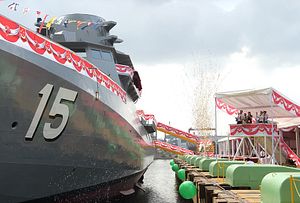Last Friday, the Republic of Singapore Navy (RSN) launched the first of eight new, locally made littoral warships called Independence.
The launching ceremony of the first Littoral Mission Vessel (LMV) was held at the Singapore Technologies Marine (ST Marine)’s Benoi shipyard. The new LMVs will replace the existing Fearless-class Patrol vessels which have been in service for 20 years.
According to information in a statement released by the Ministry of Defense (MINDEF), the LMVs – which it calls “smarter, faster and sharper” – are a marked improvement from its predecessor in several ways. The first is their versatility and flexibility to deal with a wide spectrum of challenges. LMVs have various customizable mission modules that can be reconfigured to perform a range of roles ranging from counter-piracy to humanitarian assistance and disaster relief operations. They are also equipped with an array of lethal and non-lethal options to deliver calibrated responses to a diverse set of threats, including advanced radars and sensors and a 360-degree bridge.
Second, in terms of metrics, the new vessels boast greater endurance and speed. They are twice the size of their predecessor and can travel much further and faster. LMVs can hit speeds in excess of 27 knots and travel 3,500 nautical miles for up to 14 days at sea without refueling. That means they will be able to respond quickly to maritime security incidents and will be able to stay out at sea for much longer. Furthermore, Defense Minister Ng Eng Hen stressed in his remarks at the launching ceremony that due to the engineering work done on the vessels, they will require half the maintenance time compared to the patrol vessels.
Third, the sense-making and decision support systems in the LMVs with a high level of automation allow for a much leaner crew. LMVs only require 23 men to crew at the baseline level compared to around 30 for the previous generation of patrol vessels. That is significant because, as I emphasized in an earlier piece, Singapore’s leaders recognize that the military will face a significant manpower challenge.
Fourth, it boasts a much greater level of centralization. For instance, the Integrated Command Center – a centralized operating center comprising the Bridge, Combat Information Center and Machine Control Room – integrates and synergizes the management of the navigation, engineering and combat functions. According to Lieutenant-Colonel Tay Choong Hern, the LMV Independence’s Commanding Officer, the Center will allow for more seamless communication between various teams, thereby boosting overall situational awareness. Such a capability is one which few navies have up to this point.
Aside from these capabilities, the vessels have also been tailored to suit the specific needs of RSN personnel. Every button or switch on the ship’s console, and even the height of the chairs, are tailored to the height of sailors, the length of their arms and other habits that they have while operating the vessels. As DSTA naval systems program director Matthew Yong put it, “we ensure our systems suit the operators rather than the operators to get used to the technology.”
According to MINDEF, Independence will be delivered to the RSN in 2016 and is expected to be fully operational by 2017. All eight LMVs are expected to be fully operational by 2020.

































